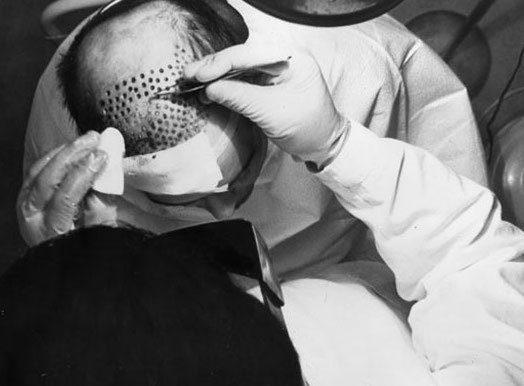“Hair Plugs” Hair Transplant Surgery – Is it Still Performed?
One of the misconceptions about a hair transplant is that some members of the general public think they are still performed using what is commonly referred to as “hair plugs”. This term refers to the type of hair transplants that were performed starting in the 1950s and lasting until the late 1990s/early 2000s. During this type of hair transplant procedure, the surgeon would “punch out” large sections of hair and skin from the donor area on the back of the scalp in order to transplant the hair grafts into the balding sections of the scalp.
Is hair plug surgery still performed? Let’s take a look at the history of this technique along with the evolution of hair transplant surgery to get the answer.
Hair Plugs History – How it Started
 The use of hair plugs was first performed by Dr. Norman Orentreich in the 1950s. The plugs (also known as round sections of hair follicles and skin) were removed from the back of the head and were generally about four millimeters across.
The use of hair plugs was first performed by Dr. Norman Orentreich in the 1950s. The plugs (also known as round sections of hair follicles and skin) were removed from the back of the head and were generally about four millimeters across.
While the hair plugs were inserted into the balding areas of the scalp, the final results were not as natural in appearance as modern hair transplant techniques. The appearance of the hair plugs was often referred to as “doll hair” or “doll-like” in nature. As time passed, surgeons were able to use hair grafts that were smaller in size and the results became more natural in appearance.
Hair Plugs – Is This Hair Transplant Technique Still Performed
Hair plugs finally fell out of style and were considered to be outdated by the start of the 21st century. They were eventually replaced by the use of Follicular Unit Transplantation (FUT) and Follicular Unit Extraction (FUE). These techniques are more advanced and are able to be performed quicker than hair plugs while providing natural results that last a lifetime.
Patients prefer to have FUE as the hair grafts are removed on an individual basis from the donor area of the scalp (usually the back and sides of the scalp). The hair from the donor area is resistant to balding and will grow like natural hair once it is transplanted into the balding section of the scalp.
Unlike hair plugs, there is little risk of scarring after the procedure. Plus, the act of individually transplanting hair follicles from the donor area of the scalp means the surgeon is able to achieve a more natural look than is possible with hair plugs that are larger in size.
Hair Plugs Risks and Side Effects
While hair plugs were a revolutionary method of restoring the hair on the scalp, there were many risk and side effects during the procedure. Some of the most common risks patients needed to worry about included:
- Scarring on the scalp after the procedure
- Results that looked like the hair on a doll
- Swelling
- Pain
- Numbness in the area where the hair plugs were removed and/or where they were implanted in the scalp
- Bleeding
- Infection
- Ingrown hairs
Hair Plugs and a Hair Transplant – Can Patients Switch from One to Another
Patients that received hair plugs in the past might not be sure if they can update and/or revise their results using a modern hair transplant method like FUE.
It is possible for previous hair plugs patients to undergo a modern hair transplant if they have enough available donor hair on the scalp or elsewhere on the body (such as the beard or the chest). The amount of available donor hair on the body of a patient can be determined during a consultation appointment with a board-certified doctor that is experienced in performing hair transplants.
It is not an option to have an additional hair plugs procedure as this is considered to be an obsolete hair transplant method. Even though some people still use the term “hair plugs” to refer to hair transplants using modern techniques, this hair restoration method is not performed in the present day.
Hair Transplant – How to Start the Process
The first step in having a hair transplant is performing proper research to learn more about the procedure including what is involved in having the surgery. A potential patient also needs to research doctors in their area, or across the country, to learn more about the results they have provided actual patients in the past.
Once the decision is made about which doctor to visit, a consultation appointment should be scheduled in order to have a one-on-one meeting with the surgeon. The doctor will examine the scalp of the patient to assess the available amount of donor hair along with performing a general physical examination of the patient to make sure the person is healthy enough to have a surgical procedure.
The consultation appointment is also the time for the patient to ask any questions they have about the hair transplant process and for the doctor to set realistic expectations about the final results.
Anyone interested in enjoying the results provided by modern hair transplant techniques is invited to contact out team today to schedule a consultation appointment at any of our California offices: